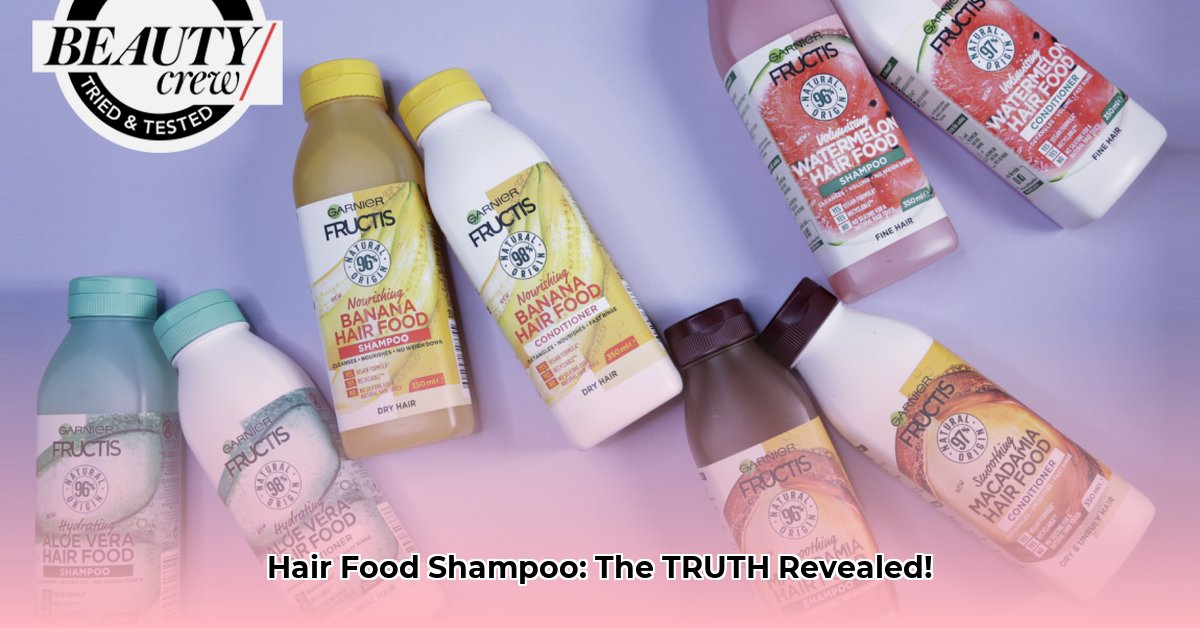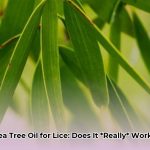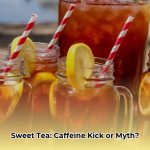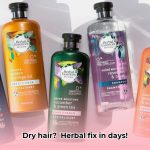Picking a shampoo can be tough, right? So many choices, so many promises! This review dives deep into Hair Food shampoos – the good, the bad, and the maybe-not-so-scientific. We’ll look at what people actually say about them (the customer reviews!), break down the ingredients to see what’s really in there, and compare them to other shampoos out there. Think of it as your cheat sheet to figuring out if Hair Food is the right fit for your hair. We’ll cover all the popular types, like Argan & Avocado and Tea Tree & Lavender, and help you decide which one (if any!) is best for you.
Hair Food Shampoo: Honest Customer Feedback & Analysis
Let’s talk about Hair Food shampoo – the brand that’s been making waves in the natural hair care scene. It promises a clean, botanical approach, but is it all it’s cracked up to be? We’ll dive deep into customer experiences, ingredient lists, and what the science (or lack thereof) tells us. Are natural ingredients enough to deliver on their claims for your hair? What are the key aspects consumers should consider before purchasing Hair Food shampoo?
What’s the Buzz About Hair Food Shampoo?
Hair Food quickly gained popularity by emphasizing its “clean” and natural ingredients. They offer a range of shampoos, each formulated with different botanical extracts to target various hair types and concerns. You’ll find options like Argan & Avocado, Tea Tree & Lavender, and Coconut & Argan Oil. But does this natural approach translate to awesome results for your hair? That’s what we aim to find out. How does Hair Food Shampoo stand out or fall short in the competitive hair care market?
Real People, Real Hair: The Customer Experience
Online reviews are overwhelmingly positive. Many users rave about softer, more manageable hair with significantly less frizz. These benefits seem to consistently pop up across the different Hair Food shampoo varieties. People describe their hair feeling healthier and looking shinier. These are all amazing things to hear from satisfied customers! What common benefits and drawbacks do users highlight in their reviews of Hair Food shampoo?
However, it’s not all sunshine and roses. Some customers report inconsistent results. What works wonders for one person might leave another feeling underwhelmed. This highlights the crucial fact that everyone’s hair is unique and reacts differently to different products. Some people even mentioned the shampoo didn’t quite live up to their expectations based on the marketing. Keep in mind individual results can vary wildly. What factors might contribute to the inconsistent results reported by some Hair Food shampoo users?
Under the Microscope: A Look at the Ingredients
Hair Food shampoos are marketed as “clean,” meaning they generally steer clear of harsh chemicals like sulfates, parabens, phthalates, and artificial dyes. This is a huge selling point for many consumers who are increasingly seeking out more natural and ethical beauty products. The key players are often botanical extracts like argan oil (known for its moisturizing prowess), tea tree oil (often used for its potential scalp-soothing properties), and lavender (often associated with calming effects). What are the key ingredients in Hair Food shampoos, and what benefits do they offer?
However, here’s the catch: While these ingredients sound fantastic, we need more concrete scientific backing to confirm the extent of their effectiveness in shampoo formulations. Many of the benefits are based on the individual properties of these ingredients in isolation, not necessarily within the specific shampoo’s formula. More research could better define the actual effects within the product. Are the botanical extracts in Hair Food shampoos scientifically proven to be effective in shampoo formulations?
The Science (or Lack Thereof): What the Research Says (or Doesn’t)
This is where things get a little tricky. While many users report positive changes in their hair, there’s a noticeable absence of independent, third-party clinical trials to back up Hair Food’s claims. This lack of scientific validation is a significant thing to consider. It means the positive experiences are mostly anecdotal, based on individual reports, rather than on rigorous testing. Compare this to major brands that often invest heavily in clinical studies to demonstrate their product’s efficacy. The absence of this evidence means you’re largely relying on user reviews to inform your decision. How does the lack of independent clinical trials impact the credibility of Hair Food’s claims?
Marketing Magic: How Hair Food Tells Its Story
Hair Food’s marketing strategy is clever. They focus heavily on their “natural” and “clean” image, appealing to the growing number of consumers who prioritize ethical and sustainable products. Their messaging skillfully connects with this audience by emphasizing their commitment to responsible sourcing and environmental consciousness. This narrative sets them apart in a really competitive market. However, we need to consider if this effective branding truly reflects the product’s overall performance. How does Hair Food’s branding influence consumer perception, and does it accurately reflect the product’s performance and sourcing practices?
The Competition: Where Hair Food Fits In
The market for natural hair care products is booming. Established players have an advantage – years of research and powerful marketing budgets. Hair Food takes a different path, focusing on simplicity and appealing to a desire for natural ingredients. While they cleverly use customer testimonials, they lack third-party, scientifically validated evidence that many consumers may look for when choosing a hair care brand. Ultimately, the consumer must weigh whether the positive user experience outweighs the absence of robust scientific proof. How does Hair Food shampoo compare to competitors in the natural hair care market, and what are its key differentiators?
Weighing the Pros and Cons: A Balanced Perspective
| Pros | Cons |
|---|---|
| Abundant positive customer reviews and testimonials | Lack of independent scientific studies to confirm claims |
| “Clean” formulation, free of many harsh chemicals | Some users report inconsistent results |
| Strong brand storytelling emphasizing natural ingredients | Transparency regarding ingredient sourcing and sustainability could be improved |
| Wide variety of shampoos for diverse hair types | May be priced higher than comparable brands |
The Bottom Line: Your Informed Decision
Ultimately, choosing Hair Food shampoo is a personal one. The abundance of positive user feedback is undeniably compelling, but you need to weigh the lack of independent scientific validation alongside these testimonials. Consider your own hair type and needs. Read through the ingredient list carefully. And remember, the best test is trying it yourself and seeing how your hair responds! What are the key factors to consider when making an informed decision about purchasing Hair Food shampoo?
How to Verify Hair Food Brand Sustainability Claims
Key Takeaways:
- Hair Food shampoos boast some beneficial ingredients but also include potentially problematic additives.
- Independent verification of Hair Food’s sustainability and efficacy claims is lacking.
- Consumer reviews are positive overall, but concerns exist regarding potential health impacts from certain ingredients.
- How to verify Hair Food brand sustainability claims requires careful ingredient examination, scrutiny of marketing materials, and consideration of independent certifications (or their absence).
Ingredient Spotlight: Benefits and Concerns
Let’s dissect the Hair Food shampoo ingredient list. Many shampoos in the line contain ingredients backed by research, like coconut oil (great for damaged hair), panthenol (for hydration), and tea tree oil (known for its scalp-soothing properties). These are definite pluses. However, the presence of fragrance and phenoxyethanol is a concern. Fragrance, while masking unpleasant smells, can also irritate sensitive scalps. Phenoxyethanol is a preservative; some studies suggest potential health risks even at low concentrations. Remember, the amount and interaction of these ingredients are also important. Does the presence of fragrance and phenoxyethanol outweigh the benefits of Hair Food shampoo, and what are the potential risks associated with these ingredients?
Another point to consider: the brand uses “coconut fruit extract.” While related to coconut oil, its effectiveness isn’t as well-established. Is this a cost-cutting measure? It’s a question worth pondering, especially when evaluating a brand’s commitment to quality. And let’s not forget the past benzene contamination issue. This raises serious questions about the brand’s quality control procedures. Does the use of “coconut fruit extract” compromise Hair Food shampoo’s efficacy, and what impact did the benzene contamination issue have on the brand’s reputation?
Deciphering the Marketing: What to Look For
Hair Food’s marketing emphasizes “natural” ingredients and ethical sourcing. But how can we confirm these claims? How to verify Hair Food brand sustainability claims often hinges upon analyzing these marketing messages. Look for specific sourcing information. Where are the ingredients from? Are they sustainably harvested or farmed? The brand’s website and packaging should offer transparency. Look for third-party certifications. Do independent organizations verify their sustainability practices? Certifications from reputable groups offer independent confirmation of claims. The absence of such certifications should trigger a critical assessment. What certifications should consumers look for to verify Hair Food’s sustainability claims, and what resources are available to research ingredient sourcing and sustainability practices?
Customer Feedback: A Mixed Bag
Online reviews reveal a generally favorable experience for many users. They praise the shampoos for softness, manageability, and frizz reduction. However, some users report irritation or allergic reactions, potentially linked to the fragrance and preservatives mentioned previously. Remember, individual reactions can vary greatly. Do the benefits outweigh the potential risks highlighted in customer feedback, and what steps can consumers take to minimize the risk of irritation or allergic reactions?
The Verdict: Informed Choices
So, what’s the takeaway? Hair Food shampoos offer accessible and affordable options. Many customers enjoy them. However, a critical consumer must weigh the potential benefits against the risks associated with certain ingredients and the lack of comprehensive independent studies validating their claims. Before purchasing, review the specific ingredient list of the shampoo variant
- Unlock Young Doctors’ Work-Life Balance: Actionable Strategies Now - December 2, 2025
- Unlock Life Harmony: Work-Life Integration Guide - November 30, 2025
- Unlock Work-Life Harmony:Your Guide to Integration - November 27, 2025
















